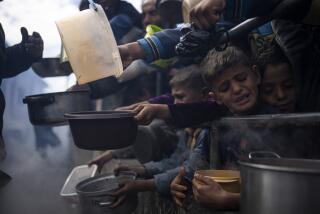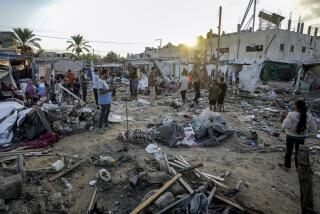Soviets See Afghanistan Move as Boost to Image : U.N. Report Details Warâs Human Toll
PESHAWAR, Pakistan â A U.N. report on the devastation caused by nine years of war in Afghanistan paints a stark picture:
Herat province--600 of 1,300 villages âseriously damaged or totally destroyed,â 60% of all trees âcut down for security reasons,â 1,123 human limbs amputated in the past five years--âthe great majority of the victims children below 15 yearsâ--because of anti-personnel mines, 400 primary schoolteachers killed, âthe majority of schools destroyed,â agriculturalproduction âdown more than 50% from prewar levels.â
Kunar province--âMajor war damage,â âmajority of population has fled,â roads in âappalling condition, many of them mined,â pine forests âstripped bare,â education and health facilities ânon-existent,â âphysical infrastructure . . . badly run down or destroyed.â
Paktia province--âHealth situation . . . critical, not a single doctor is present,â âall schools are closed, the teachers gone,â âmines scattered on roads and in fields,â agricultural output âless than one-fourth prewar levels.â
The Soviet intervention in Afghanistan ended officially at 11:20 a.m. Wednesday when Lt. Gen. Boris Gromov, commander of Soviet troops in Afghanistan, stepped across the border and back into the Soviet Union. A ceremony welcomed him as the last Soviet soldier to leave.
15,000 Soviets Dead
For the Soviets, who lost 15,000 men killed and had tens of thousands of others maimed, it meant that the war was finally over. For Americans, who funneled billions of dollars in arms, ammunition and other supplies to the Islamic rebel movement that helped drive the Soviets out, it was a victory.
But for the Afghans, there was no celebration Wednesday.
âI talked to eight Afghans today, and not one of them mentioned the Soviet withdrawal,â a Western diplomat in Pakistan said. âToday is really an American victory. For the Afghans, the war still goes on.â
The regime of Afghan President Najibullah, installed and propped up by the Soviets, is still in place. The cities, reeling under shortages of bread, fuel and other necessities, are under siege by the Islamic guerrillas, who continue to pummel them with rocket and mortar fire. The 31 largely rural provinces, like Kunar, Herat and Paktia, have been turned into a virtual wasteland, barely capable of supporting human life.
Million Believed Killed
More than a million Afghans are believed to have been killed. Five million others, a third of the population, are refugees in mud-walled camps scattered over the border regions of Pakistan and Iran. And according to the U.N. survey, the 9 million Afghans still in the country face famine, epidemic and starvation.
Despite all the international attention focused on the impoverished country, efforts to prepare it for peace are lagging seriously. The U.N. program for the rehabilitation and reconstruction of Afghanistan, announced last year, has bogged down in diplomatic wrangling and charges of inefficiency and disorder in the agency set up to administer it.
According to diplomats representing donor nations, and according to independent aid workers and Pakistani officials in Peshawar, which has been Afghan refugee headquarters since the war began, Afghanistan is no better prepared for the end of the war than it was nearly a year ago, when planning began.
From the U.N. effort to raise more than $1 billion in reconstruction funds to the crucial program to clear the many unexploded land mines and shells, the project has been plagued by delays and administrative problems, say senior diplomats and aid workers. Many fear this will delay the return of what is now the worldâs largest refugee population.
Prince Sadruddin Aga Khan, who was appointed overall coordinator of the U.N. program, conceded at a press conference here Sunday that since October he has managed to raise just $238 million in cash donations towards the $1-billion reconstruction program.
An additional $650 million of in-kind contributions were pledged by the Soviet Union, but Sadruddin said the United Nations needs cash to feed the refugees and build the roads, bridges, irrigation canals and houses they will need when they return.
âIf the infrastructure isnât there--and at this rate it wonât be--the refugees will starve when they go back,â said one Pakistani refugee official in Peshawar.
According to the U.N. report, the donations received so far âconstitute no more than a drop in an ocean of need.â It said that less than $30 million of the pledged donations had been received.
Diplomats blamed the U.N. coordinating agency for the shortfall. One, representing a country that pledged tens of millions of dollars last October, said he has yet to be contacted by Sadruddinâs office for the money.
Critical of U.N. Staff
Other diplomats and aid workers said the U.N. staff appointed to handle the aid effort is âconsumed by minutiae,â âobsessed by politicsâ and âmore interested in the hype than the help.â
The agencyâs critics say its mine clearance program is an example of its inefficiency. Estimates of the number of land mines that were strewn across Afghanistan by the Soviets and the guerrillas range from 1 million to 30 million. Experts say it will take months to train enough refugees to make the program work.
A number of refugees who tried to go back to their villages from camps in Pakistan, after the villages were liberated by the guerrillas last summer, have returned to Pakistan missing arms and legs blown off by mines in wheat fields and along village paths.
Most refugee officials agree that the mines could be a serious deterrent to refugees who may want to go home. Tremendous pressure has been brought to bear on the United Nations to start training classes in mine recognition and disposal. But as one diplomat complained, âthe United Nations is doing absolutely nothing to get this program under way.â
He added, âIf the rebels won the war tomorrow and told the refugees to go home, most of them would be back a few weeks later missing their hands and feet.â
Foreign Disposal Experts
The U.S. government, which has donated $2 million to the mine disposal program, has sent 38 U.S. Army detonation experts to Peshawar, and they were joined the other day by mine disposal teams from France and Turkey.
But still the United Nations has failed to start the program, and the experts have been sitting in Peshawar with little or nothing to do.
Western diplomats have also criticized Prince Sadruddin for failing to obtain mines from the Soviets to use as teaching tools, despite several high-level meetings with the Soviets.
A Western expert said 31 types of Soviet mines are involved and âwe need hundreds of them to teach these refugees how to get rid of them.â He said U.S. intelligence agencies have only a small number of the mines.
The critics charge that the U.N. coordinator is preoccupied with an ambition to become U.N. secretary general, a post that would require the endorsement of the Soviet Union. Sadruddin denies the charge.
Talking about the difficulties in coordinating the huge reconstruction program, Sadruddin said: âWe face an extraordinarily complex situation. . . . We are treading new ground.â
He said his role is made all the more difficult because of the United Nationsâ neutral role and its inability to predict who will be in power in Kabul when the refugees decide to go home.
One of the most senior Pakistani refugee officials, who had helped to coordinate the care and feeding of 3.2 million people, has been sharply critical of the U.N. effort.
He said Sadruddinâs agency has not built a single storage facility for the 350,000 tons of wheat the United Nations estimates will be needed in Afghanistan if only half the refugees decide to return this year. The U.N. agencies involved in the effort, he said, have âmade a lot of fuss and propaganda but not done any work.â
More to Read
Sign up for Essential California
The most important California stories and recommendations in your inbox every morning.
You may occasionally receive promotional content from the Los Angeles Times.









